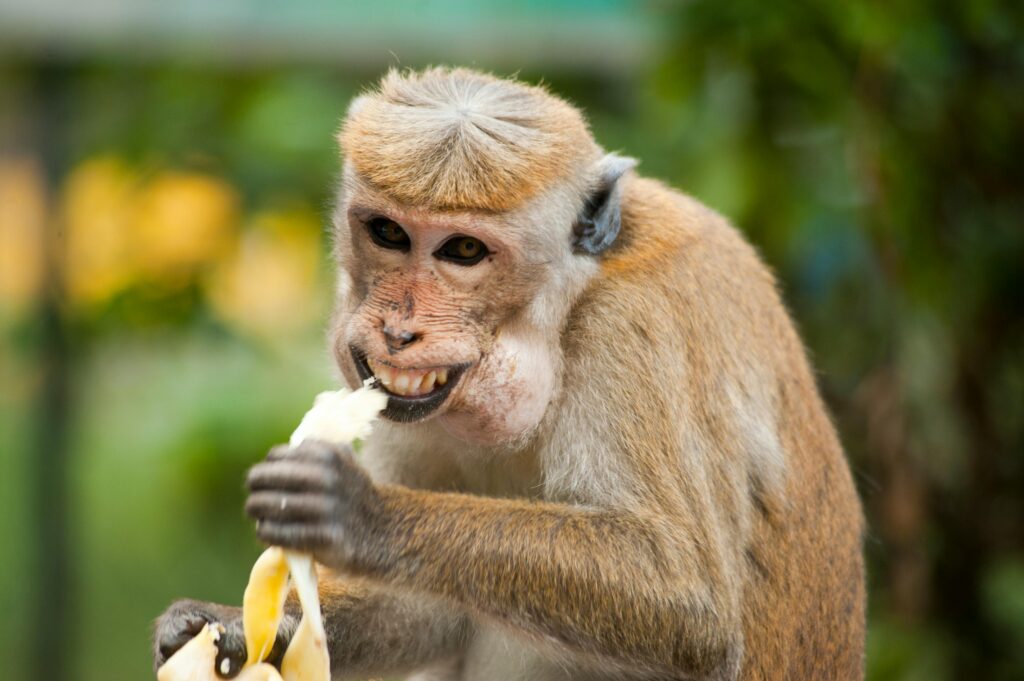Sri Lanka

Monkey Smile
Sri Lanka may be small, but its wildlife is mighty. This teardrop-shaped island is packed with biodiversity — from blue whales in the deep south to leopards in golden plains, from wild elephants roaming ancient temples to tiny lorises blinking in moonlight. With lush forests, coastal lagoons, misty hills, and arid scrublands all packed into one island, Sri Lanka offers a wild experience unlike anywhere else in Asia.
What Makes Sri Lanka Special?
Sri Lanka is a biodiversity hotspot — home to more than 120 species of mammals, hundreds of birds, and unique endemics found nowhere else. What’s remarkable is how easy it is to access. In just one day, you could watch wild elephants bathe in a tank, photograph colorful birds in wetlands, and scan the seas for the largest animal ever to live: the blue whale.
Top Wildlife Experiences in Sri Lanka:
Wildlife Behaviors You’ll Notice Here:
Sri Lanka’s animals often live side by side with people. Elephants cross tea estates and rice paddies. Monkeys scamper over rooftops. Even leopards are occasionally spotted in rural villages. But their behaviors shift fast: in parks they’re calm, in conflict zones, they become nocturnal and cautious. Peacocks dance in the open, but lorises only emerge after dark. Understanding when and where to look changes everything.
Rare and Endemic Species:
Sri Lanka’s isolation has given rise to creatures found nowhere else:
When to Visit for the Best Sightings:
Wildlife can be seen year-round, but timing matters. The best dry season for the southern parks (Yala, Udawalawe) is December to April. For whale watching, visit Mirissa between November and April, and Trincomalee from May to August. Monsoon rains vary by region, so plan your route accordingly. Animals are most active in the cool hours of morning and evening.
Threats and Conservation Challenges:
Sri Lanka’s wildlife faces increasing pressure:
Final Reflections:
To explore Sri Lanka’s wild side is to step into ancient rhythm. Here, elephants still walk paths worn over centuries, and whales cross warm oceans like they always have. Look beyond the big names. Watch for the details — a gecko on a banyan tree, a frog hiding in a leaf, a loris blinking in a torch beam. Sri Lanka’s magic lies in its quiet, its surprises, and the wild life still hanging on — sometimes boldly, sometimes in silence, always worth seeing.
What Makes Sri Lanka Special?
Sri Lanka is a biodiversity hotspot — home to more than 120 species of mammals, hundreds of birds, and unique endemics found nowhere else. What’s remarkable is how easy it is to access. In just one day, you could watch wild elephants bathe in a tank, photograph colorful birds in wetlands, and scan the seas for the largest animal ever to live: the blue whale.
Top Wildlife Experiences in Sri Lanka:
- Yala National Park: One of the best places in the world to see leopards in the wild. Dry, open terrain makes sightings frequent, especially at dawn and dusk.
- Udawalawe National Park: Known for its large elephant herds and excellent photography opportunities in open grasslands.
- Wilpattu National Park: Sri Lanka’s oldest and quietest major park, famous for natural lakes and a good chance of seeing both leopards and sloth bears.
- Sinharaja Forest Reserve: A mystical rainforest teeming with endemic birds, amphibians, and butterflies. No big cats here — just ancient silence and life under dense canopies.
- Mirissa & Trincomalee Coast: Offshore boat trips reveal sperm whales, spinner dolphins, and seasonal blue whales — all within reach of the beach.
Wildlife Behaviors You’ll Notice Here:
Sri Lanka’s animals often live side by side with people. Elephants cross tea estates and rice paddies. Monkeys scamper over rooftops. Even leopards are occasionally spotted in rural villages. But their behaviors shift fast: in parks they’re calm, in conflict zones, they become nocturnal and cautious. Peacocks dance in the open, but lorises only emerge after dark. Understanding when and where to look changes everything.
Rare and Endemic Species:
Sri Lanka’s isolation has given rise to creatures found nowhere else:
- Red Slender Loris: A tiny, wide-eyed primate only seen at night, in the lowland rainforests.
- Purple-faced Langur: A shy leaf-eating monkey, often spotted high in the trees, especially in the hills around Kandy.
- Toque Macaque: A cheeky, temple-loving monkey endemic to Sri Lanka, featured in many documentaries.
- Sri Lankan Junglefowl: The country’s national bird, and a wild cousin of the domestic chicken.
When to Visit for the Best Sightings:
Wildlife can be seen year-round, but timing matters. The best dry season for the southern parks (Yala, Udawalawe) is December to April. For whale watching, visit Mirissa between November and April, and Trincomalee from May to August. Monsoon rains vary by region, so plan your route accordingly. Animals are most active in the cool hours of morning and evening.
Threats and Conservation Challenges:
Sri Lanka’s wildlife faces increasing pressure:
- Human-elephant conflict: As farmland expands, elephants lose their corridors. Fence lines grow, and so do casualties — on both sides.
- Illegal pet trade: Lorises, tortoises, and birds are still trapped and sold despite protection laws.
- Habitat fragmentation: Forests are shrinking and splitting, forcing animals into smaller, disconnected areas.
- Over-tourism in Yala: Crowds of jeeps at a single leopard sighting can stress animals and reduce natural behavior.
Final Reflections:
To explore Sri Lanka’s wild side is to step into ancient rhythm. Here, elephants still walk paths worn over centuries, and whales cross warm oceans like they always have. Look beyond the big names. Watch for the details — a gecko on a banyan tree, a frog hiding in a leaf, a loris blinking in a torch beam. Sri Lanka’s magic lies in its quiet, its surprises, and the wild life still hanging on — sometimes boldly, sometimes in silence, always worth seeing.
